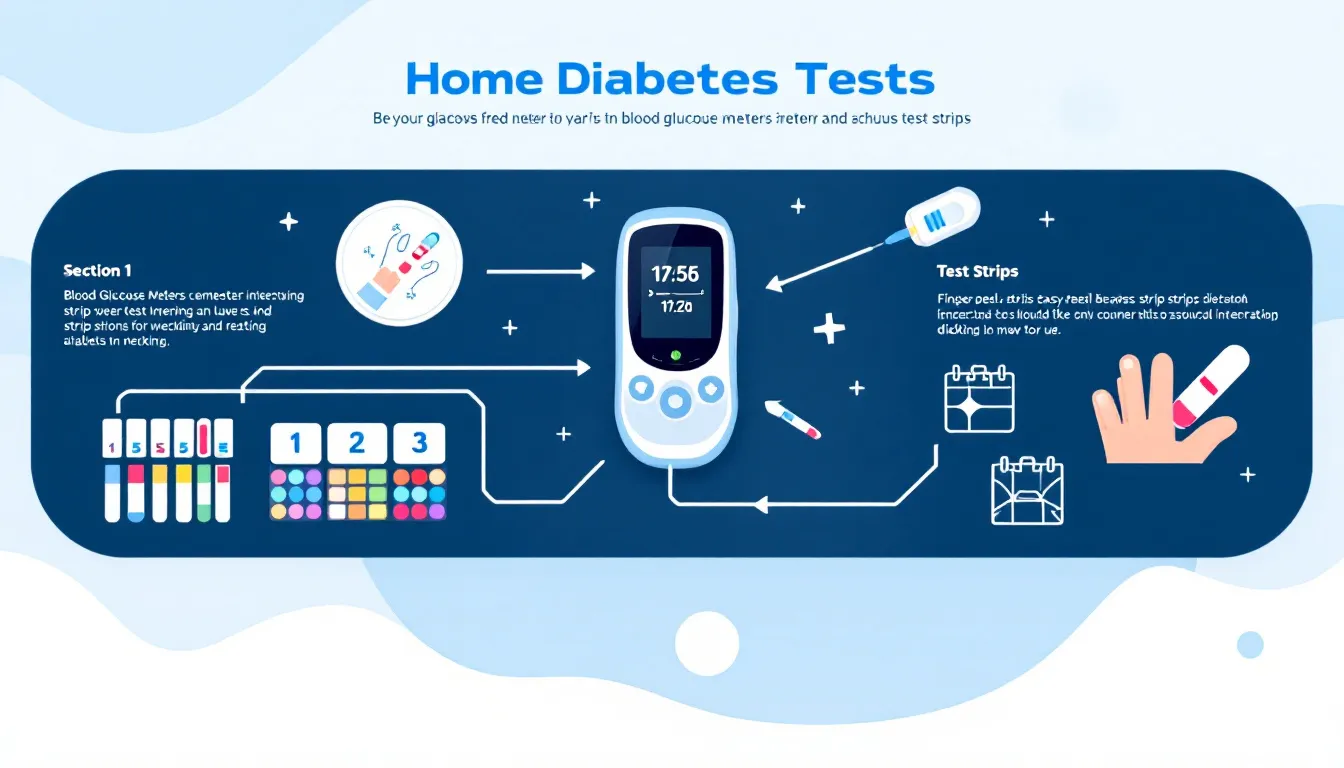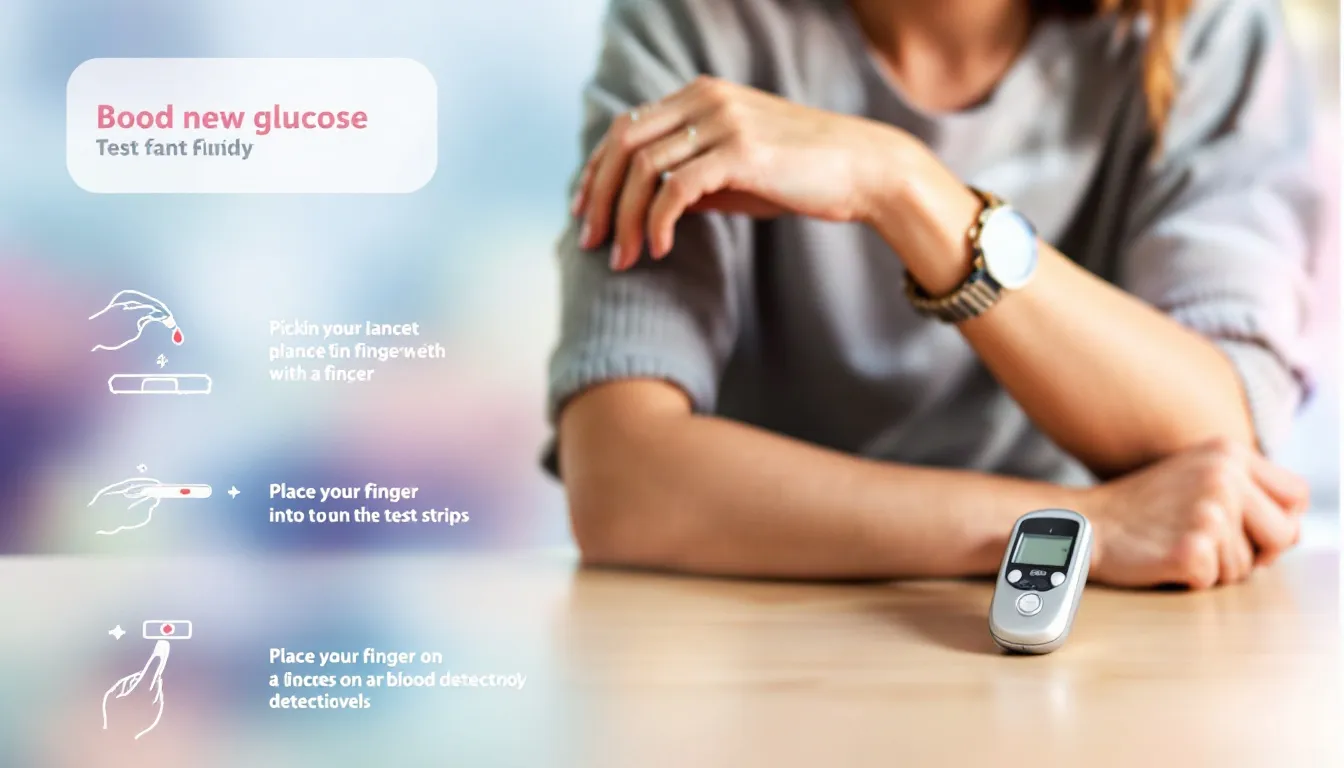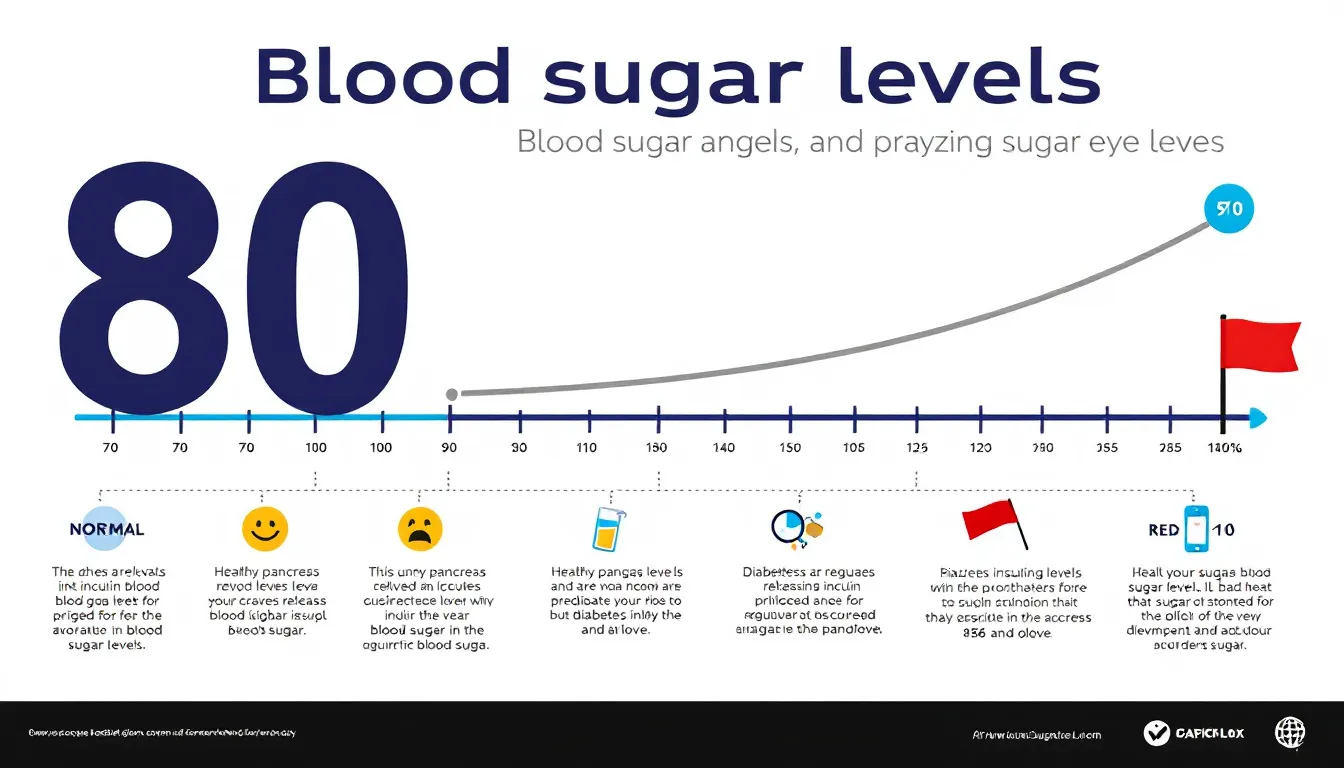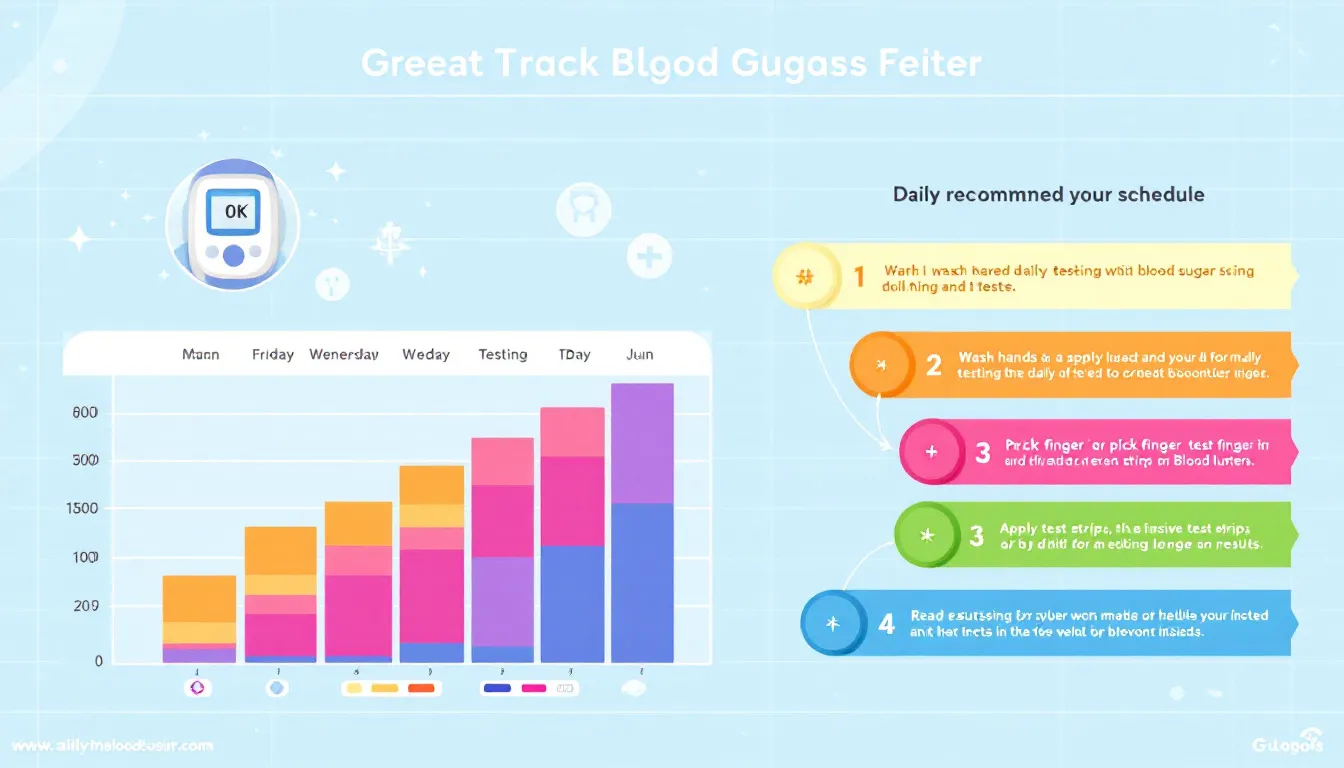You can test for diabetes at home using various methods. This guide will help you understand different home tests, how to use them, and interpret the results.
Key Takeaways
- Home testing for diabetes enables early detection and better management of blood sugar levels, helping to prevent complications.
- Common symptoms of diabetes include excessive thirst, increased hunger, and fatigue; recognizing these early can aid in timely diagnosis and treatment.
- Various home testing methods, including blood glucose meters, continuous glucose monitors (CGMs), and urine test kits, provide options for individuals to monitor their blood sugar levels effectively.
Why Test for Diabetes at Home?

Early detection through home testing can prevent diabetes complications associated with diabetes. Regularly checking your blood sugar levels allows you to spot any unusual patterns and address them before they turn into serious health problems. Imagine being able to catch high blood sugar levels early and taking steps to manage them before they lead to complications. Home testing makes this possible, facilitating early diagnosis.
Self-monitoring blood glucose empowers individuals to manage their diabetes more effectively. When you can see your blood glucose readings in real-time, you gain a better understanding of how your body reacts to different foods, activities, and medications. This knowledge helps you make informed decisions that can improve your overall health and well-being.
Home testing also helps you identify patterns in blood sugar levels related to diet, physical activity, and medication. Tracking your blood glucose levels allows for lifestyle adjustments that help manage diabetes effectively. Taking a proactive approach to diabetes care management can improve health outcomes and quality of life.
Symptoms to Watch For
Identifying diabetes symptoms early is key for timely diagnose diabetes and effective management. Some common symptoms include excessive thirst, increased hunger, and frequent urination. These symptoms occur because your body is trying to get rid of excess glucose through urination, leading to dehydration and increased thirst.
Tiredness and unexplained weight loss are also common signs of diabetes. When your body can’t use glucose for energy, it starts breaking down fat and muscle for fuel, leading to weight loss. High blood sugar levels often lead to fatigue, causing tiredness and lethargy, while low blood sugar can also contribute to these symptoms.
Slow healing of cuts and skin infections, along with blurred vision, can also be indicators of diabetes complications. High blood sugar levels can damage blood vessels and nerves, impairing your body’s ability to heal and affecting your vision. Consult a healthcare professional for further testing and advice if you notice any of these symptoms.
Types of Home Diabetes Tests

Home diabetes testing devices include blood glucose meters, continuous glucose monitors (CGMs), and urine test kits. Each of these methods offers a unique way to monitor your blood sugar levels, allowing you to choose the one that best fits your lifestyle and needs.
Here’s a closer look at these options.
Blood Glucose Meters
Blood glucose meters are designed to measure glucose levels from a droplet of blood. To perform a test, a small drop of blood is required, typically obtained from the side of the fingertip using a finger-pricking device. This blood sample is then placed on a test strip, which is inserted into the blood sugar meter. Within seconds, the meter displays your blood glucose level, providing you with an immediate reading. Blood glucose tests are essential for monitoring your health.
These meters offer a quick and easy method to check blood sugar levels, making them invaluable for diabetes management. Regular maintenance of your blood glucose meter and test strips is necessary for accurate readings. Check the expiration dates and store the strips properly.
Using a blood glucose meter can help you understand how your blood sugar levels fluctuate throughout the day, allowing you to make informed decisions about your diet, exercise, and medication. Being proactive can help manage diabetes more effectively and prevent complications.
Continuous Glucose Monitors (CGMs)
A continuous glucose monitor (CGM) is a device that continuously measures glucose levels underneath the skin. These monitors use sensors placed under the skin to provide real-time glucose level readings every few minutes. Continuous monitoring reveals how blood sugar levels fluctuate throughout the day and night.
CGMs connect to devices like receivers or smartphone apps for easy glucose level tracking. They are particularly useful for people who need close monitoring of their blood glucose, such as those with diabetes. Some CGMs can even alert you when your glucose levels are outside the target range, helping you take immediate action.
However, there are some limitations to using CGMs. Certain medicines and alcohol can affect the accuracy of CGM readings. Additionally, the sensor must be replaced every 7 to 14 days to ensure accurate readings. For some continuous glucose monitors (CGMs), calibration with finger-stick blood tests might be required. This ensures the accuracy of the readings.
Despite these limitations, CGMs provide a convenient and effective method for continuous blood glucose monitoring.
Urine Test Kits
Urine test kits function by analyzing a sample of urine to detect the presence of certain substances that indicate diabetes or related conditions. These kits measure glucose levels in urine, along with other components such as ketones and proteins, which are important indicators of metabolic health.
Though not as precise as blood glucose meters or CGMs, urine test kits are crucial for diabetes detection. High glucose levels in urine can signal uncontrolled blood sugar levels, prompting further medical evaluation.
These kits are useful for initial diabetes screening test or for those who prefer non-invasive testing.
How to Use a Blood Glucose Meter

Using a blood glucose meter correctly is essential for obtaining accurate readings. This section will guide you through the process, from preparing your device to taking a blood sample and reading the results.
Here’s how to get started.
Preparing Your Device
Properly setting up your blood glucose meter ensures accurate and reliable test results. Insert the test strips according to the manufacturer’s instructions to prepare your blood glucose meter. Some meters allow testing from alternative sites, but not all devices are designed for that, potentially affecting the reliability of the results.
Always ensure that you follow the specific guidelines provided with your blood glucose meter to ensure the most reliable results. This preparation ensures that your device is ready to provide accurate readings when you need them.
Taking a Blood Sample
Thoroughly clean your hands before testing to avoid contamination and erroneous readings. Use a new lancet device for each blood sample to minimize the risk of infection. The lancet should be set to the correct depth to minimize discomfort.
Prick the side of the fingertip rather than the pad for more accurate readings. Once you have a small drop of blood, place it on the test strip and insert it into the meter. This process ensures that you get a clean and accurate blood sample for testing.
Reading and Recording Results
Recording blood glucose readings is crucial for effective diabetes management. You should record your blood sugar results as often as advised by your healthcare professional. Keeping a record helps you and your healthcare team track trends and adjust the treatment plan as needed.
Seek guidance from your healthcare professional if your blood glucose results are frequently out of range. Bring your record of results to healthcare appointments for proper management. This practice ensures that your diabetes is managed effectively and that you are on the right track.
Understanding Your Blood Sugar Levels

Comprehending your blood sugar levels is vital for effective diabetes management. A level of HbA1c of 48mmol/mol or above indicates diabetes. The HbA1c blood test measures how well blood glucose has been managed over the last 12 weeks. This test provides a long-term picture of your blood sugar control.
A fasting blood sugar level of less than 100 mg/dL is considered normal. However, a blood glucose level of 200 mg/dL (11.1 mmol/L) or higher during a random blood glucose test is indicative of diabetes. For the oral glucose tolerance test, a reading of over 200 mg/dL after two hours signals diabetes. A normal glucose level in the glucose tolerance test is less than 140 mg/dL, and monitoring blood sugar readings is essential for managing these levels.
The American Diabetes Association suggests varying blood sugar targets based on personal health factors. Results are best interpreted when compared to daily trends rather than isolated readings. Doctors or specialists set target blood glucose levels for individuals with diabetes. Knowing these levels aids in better diabetes management.
When to Test Your Blood Sugar

Individuals with type 1 diabetes should test their blood sugar levels 4 to 10 times a day. People managing type 2 diabetes with insulin often need to test their blood sugar levels multiple times a day, while those not on insulin may not need daily tests. Testing before meals, snacks, and sometimes after eating is recommended for those with type 1 diabetes.
For those on multiple insulin doses, testing before bed is recommended. Blood glucose meter results can vary based on the time of day and recent food intake. More frequent testing may be necessary during illness or routine changes. Knowing when to test helps you maintain better control of your blood sugar levels.
Troubleshooting Common Issues
Use meter-specific control solutions for checking accuracy. Periodically using control solutions helps verify the accuracy of your blood glucose meter. If your glucose meter gives unexpected results, you should double check the expiration dates of your test strips and ensure they have not been damaged.
Consult a diabetes educator or pharmacist if problems arise, and use control solutions for accuracy checks. Avoiding issues with diabetes equipment involves proper usage and maintenance. More than 2mmol/L difference is usually cause for concern when comparing readings on different meters.
If you have a problem with your diabetes equipment, check the manufacturer’s instructions or contact customer care.
Maintaining Your Testing Equipment
Correct usage and care of blood sugar meters are essential for accurate results and device longevity. Caring for blood glucose test strips is vital to get accurate readings. Make sure the batteries are charged and the meter is clean before use.
Replace the batteries in your blood glucose meter regularly to maintain functionality and accuracy. Test strips must be stored within a specific temperature range to maintain their accuracy; exposure to extreme temperatures can degrade them.
Using damaged or expired test strips can lead to high risk of incorrect blood glucose readings; tested check their condition before use.
Consulting with Healthcare Professionals
Quick access to diabetes management test results, like HbA1c, allows healthcare providers to make informed decisions and improve patient care. Sharing blood glucose trends with your healthcare team personalizes diabetes management strategies. Communicating home test results effectively can prompt timely treatment adjustments for better diabetes control.
The availability of immediate test results helps in proactively managing diabetes, aiding in better health outcomes. Recording should include the date, time, and test results for effective diabetes management. Consulting with healthcare professionals ensures that your diabetes treatment is tailored to your needs.
Summary
Testing for diabetes at home empowers individuals to take control of their health. By understanding the different testing methods, such as blood glucose meters, continuous glucose monitors, and urine test kits, you can choose the one that best fits your lifestyle. Proper use and maintenance of these devices are crucial for obtaining accurate readings and managing diabetes effectively.
Regular testing and recording of your blood sugar levels, along with consulting healthcare professionals, can help you stay on top of your diabetes management. By being proactive and informed, you can lead a healthier, more fulfilling life.
Frequently Asked Questions
How often should I test my blood sugar if I have type 1 diabetes?
You should test your blood sugar levels 4 to 10 times a day, including before meals, after eating, and before bed, to effectively manage your type 1 diabetes. Consistent monitoring is crucial for maintaining optimal health.
Can I use expired test strips with my blood glucose meter?
Using expired test strips can result in inaccurate blood glucose readings, so it’s essential to check expiration dates and store strips properly for reliable results.
What should I do if my blood glucose meter gives unexpected results?
If your blood glucose meter shows unexpected results, first check the accuracy with control solutions and ensure the test strips are not expired or damaged. If issues persist, consult a diabetes educator or pharmacist for further guidance.
What are the symptoms of diabetes I should watch for?
You should watch for excessive thirst, increased hunger, frequent urination, fatigue, unexplained weight loss, slow-healing wounds, and blurred vision. If you notice any of these symptoms, it’s important to consult a healthcare professional promptly.
Why is it important to share my blood glucose trends with my healthcare team?
Sharing your blood glucose trends with your healthcare team is crucial for personalizing diabetes management and enabling timely adjustments to treatment. This collaboration ultimately leads to improved health outcomes.
